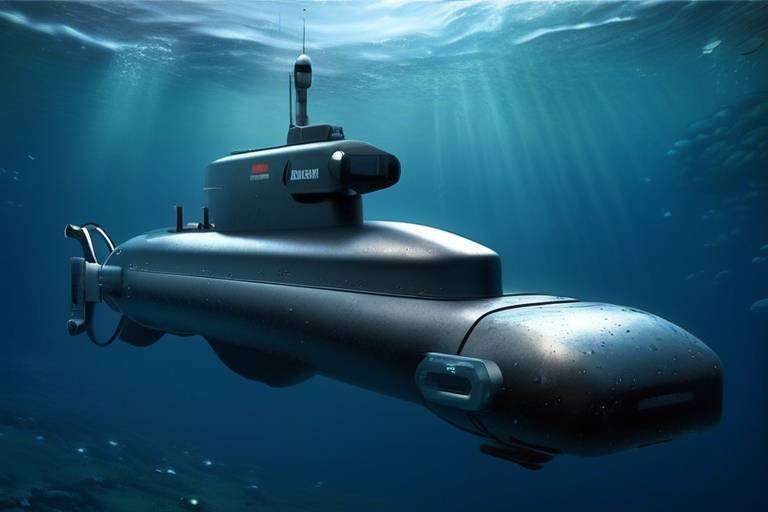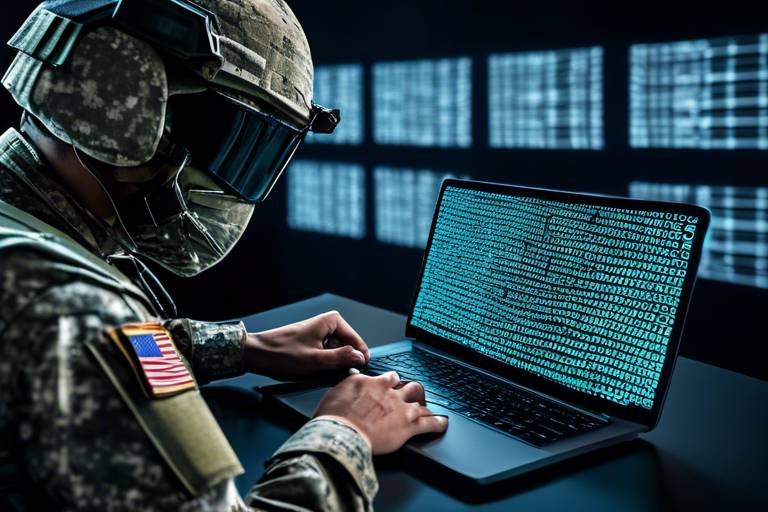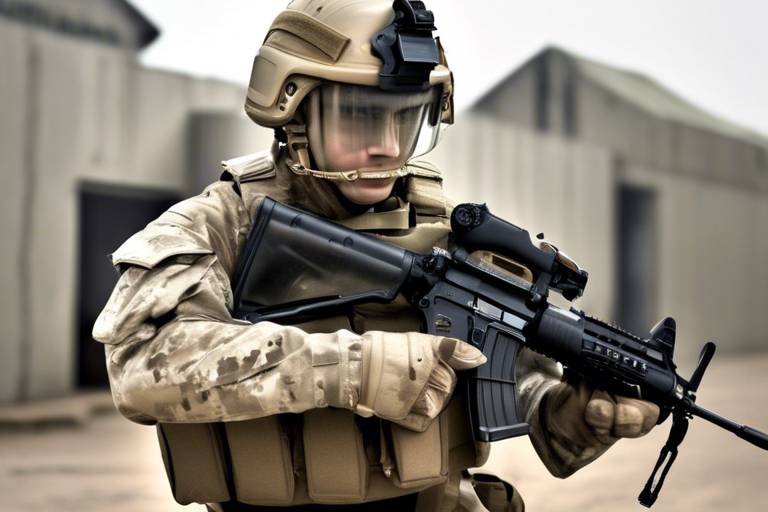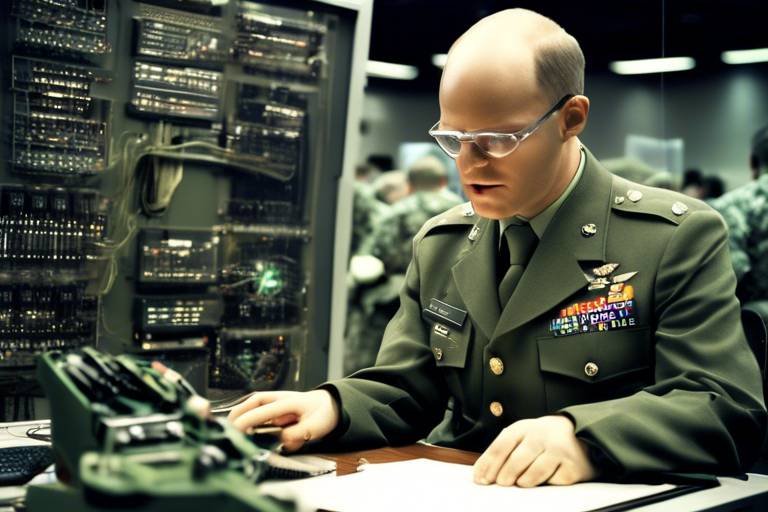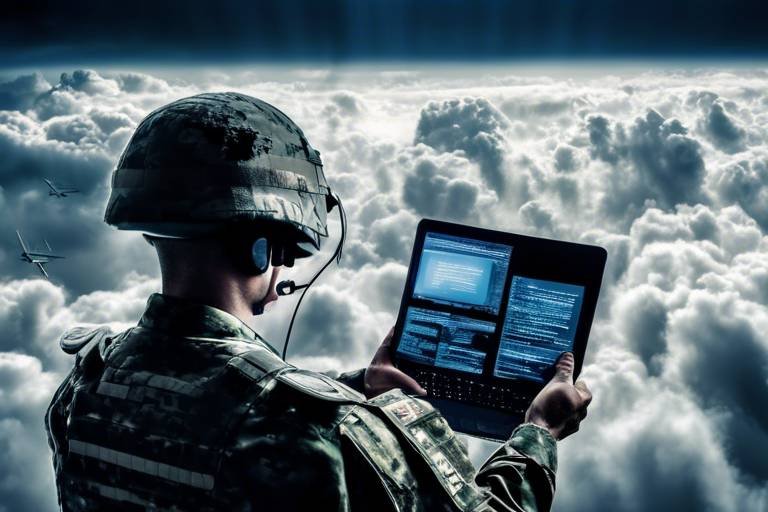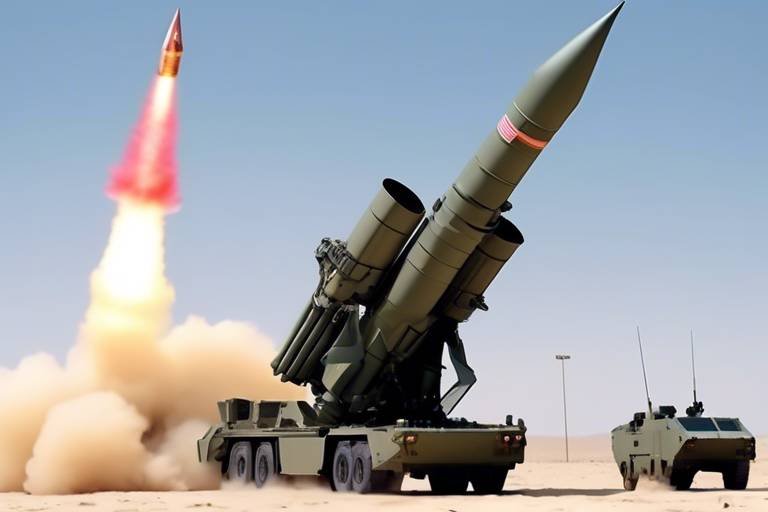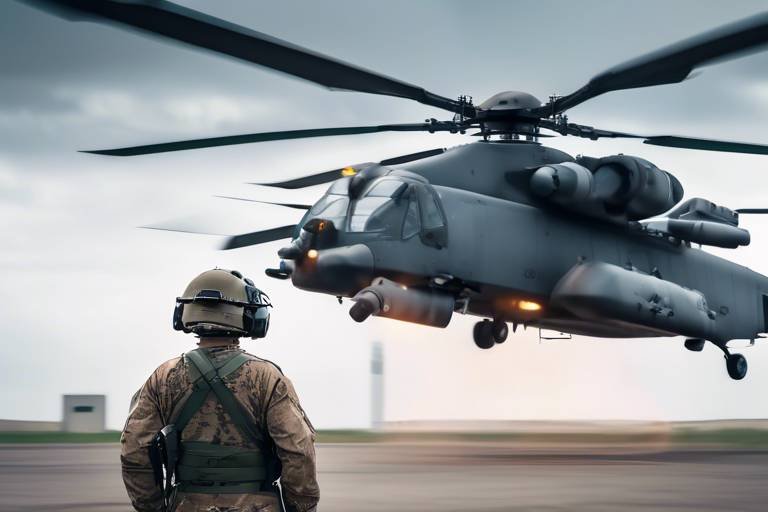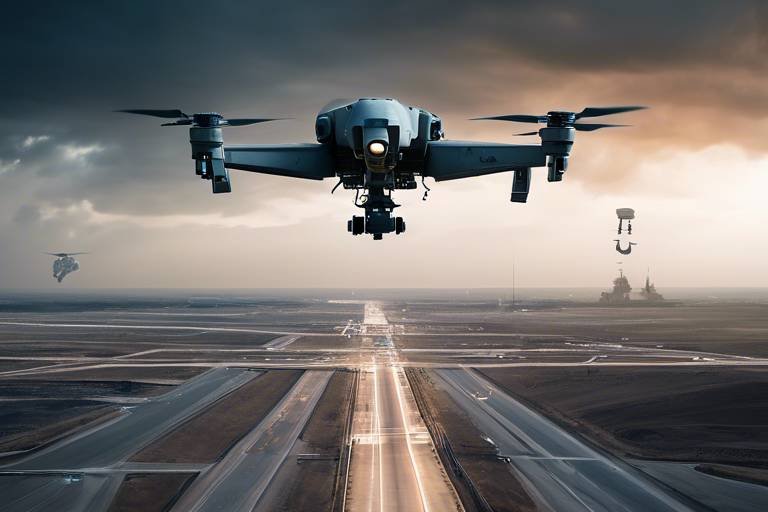Autonomous Underwater Vehicles - The Future of Naval Warfare
The world of naval warfare is evolving at a breathtaking pace, and at the forefront of this transformation are Autonomous Underwater Vehicles (AUVs). These remarkable machines are not just a technological novelty; they represent a seismic shift in how naval forces operate beneath the waves. Imagine a fleet of silent, tireless robots navigating the ocean depths, gathering intelligence, and neutralizing threats without putting human lives at risk. This is not science fiction; it's the reality of modern naval operations.
As we delve into the intricacies of AUVs, it’s essential to recognize their transformative role in enhancing operational efficiency and effectiveness. With advancements in robotics and artificial intelligence, AUVs are now capable of performing complex missions that were once the exclusive domain of manned submarines. Their ability to operate autonomously allows them to undertake reconnaissance, surveillance, and mine detection tasks, providing critical data that can turn the tide of naval engagements.
Moreover, the integration of cutting-edge technologies has propelled AUVs into a new era. Equipped with advanced sensors and communication systems, these vehicles can relay information back to command centers in real-time, ensuring that military leaders have up-to-date intelligence to make informed decisions. Imagine a naval commander receiving instant updates on enemy movements or underwater threats—this is the power of AUVs in action.
As we explore the strategic applications of AUVs, it becomes clear that they are not just tools; they are game-changers. From stealthy reconnaissance missions to the crucial task of mine detection and neutralization, AUVs provide naval forces with unparalleled advantages in various maritime environments. They can operate in hostile waters, gather intelligence without being detected, and ensure safer navigation for naval vessels—all while minimizing risk to human personnel.
However, the journey towards widespread AUV deployment is not without its challenges. Technical limitations, environmental factors, and cybersecurity concerns must be addressed to unlock the full potential of these vehicles. As we look to the future, the role of AUVs in naval warfare is expected to expand, paving the way for new tactics and strategies that will shape military operations for years to come.
- What are Autonomous Underwater Vehicles (AUVs)? AUVs are unmanned, autonomous robots that operate underwater, capable of performing various tasks such as reconnaissance, surveillance, and mine detection.
- How do AUVs improve naval warfare? AUVs enhance naval warfare by providing real-time intelligence, reducing risk to human lives, and enabling complex underwater operations.
- What challenges do AUVs face? AUVs face challenges such as technical limitations, environmental factors, and the need for robust cybersecurity measures to protect sensitive data.
- What is the future of AUVs in naval operations? The future of AUVs is promising, with expected advancements in technology and integration with other naval assets, leading to more effective maritime strategies.

Technological Innovations in AUVs
This article explores the transformative role of Autonomous Underwater Vehicles (AUVs) in modern naval warfare, their technological advancements, applications, and implications for future military strategies.
In the ever-evolving landscape of naval warfare, Autonomous Underwater Vehicles (AUVs) have emerged as game-changers, thanks to a wave of technological innovations that have significantly enhanced their capabilities. Recent advancements in robotics and artificial intelligence have transformed these underwater machines into sophisticated tools for military operations. Imagine a silent sentinel gliding through the depths of the ocean, equipped with the ability to process vast amounts of data in real-time while navigating complex underwater terrains. This is not science fiction; it's the reality of modern AUVs.
One of the most notable innovations is the integration of advanced sensors, which allow AUVs to gather detailed environmental data and conduct thorough reconnaissance missions. These sensors can include high-resolution cameras, sonar systems, and environmental monitoring tools, all designed to provide comprehensive insights into underwater conditions. For instance, AUVs can utilize sonar mapping techniques to create detailed maps of the ocean floor, identifying potential threats and obstacles that could hinder naval operations.
Furthermore, the incorporation of machine learning algorithms enables AUVs to analyze data on-the-fly, adapting their strategies based on real-time information. This capability not only enhances their operational efficiency but also minimizes the risk of human error. In essence, AUVs are becoming more autonomous, capable of making critical decisions in the heat of the moment, much like a seasoned commander navigating through a battlefield.
Another significant leap is the development of real-time communication technologies. Modern AUVs can now relay information back to command centers instantly, allowing for rapid decision-making and immediate responses to emerging threats. This level of connectivity ensures that naval forces remain one step ahead, equipped with the intelligence they need to execute their missions effectively.
As we explore the future of AUVs, it’s essential to acknowledge the role of energy efficiency in their design. Innovations in battery technology, such as lithium-ion batteries and fuel cells, are extending the operational range of AUVs, enabling them to conduct longer missions without the need for frequent recharging. This advancement is crucial for sustaining prolonged underwater operations, especially in hostile environments where surface support may be limited.
To summarize the key innovations in AUV technology, consider the following table:
| Innovation | Description |
|---|---|
| Advanced Sensors | High-resolution cameras and sonar systems for detailed reconnaissance and mapping. |
| Machine Learning | Algorithms that allow AUVs to analyze data in real-time and adapt strategies. |
| Real-time Communication | Instant data relay to command centers for improved decision-making. |
| Energy Efficiency | Innovations in battery and fuel cell technology for extended operational range. |
In conclusion, the technological innovations in AUVs are not just enhancing their capabilities; they are redefining the very nature of naval warfare. As these machines become more autonomous and intelligent, they pave the way for new strategies and operational frameworks that could change the dynamics of maritime security. The future of AUVs in naval warfare is not just bright; it's revolutionary.
- What are Autonomous Underwater Vehicles (AUVs)?
AUVs are unmanned, self-propelled vehicles designed to operate underwater, often used for military and research purposes. - How do AUVs communicate with command centers?
Modern AUVs utilize real-time communication technologies to relay information instantly, enhancing decision-making during missions. - What are the main applications of AUVs in naval warfare?
AUVs are primarily used for reconnaissance, surveillance, mine detection, and environmental monitoring. - What challenges do AUVs face?
Challenges include technical limitations, environmental factors, and the need for robust cybersecurity measures.

Strategic Applications of AUVs
In today's rapidly evolving naval warfare landscape, Autonomous Underwater Vehicles (AUVs) are becoming pivotal assets for military forces around the globe. These ingenious machines are not just submersible drones; they are transforming the way we approach maritime operations. Imagine a silent sentinel gliding through the depths, gathering crucial intelligence without ever breaking a sweat. That's the power of AUVs, and their strategic applications are as diverse as they are impactful.
One of the most prominent roles AUVs play is in reconnaissance and surveillance. Equipped with state-of-the-art sensors, AUVs can conduct stealthy missions that allow them to gather vital intelligence without putting human lives at risk. This capability is especially significant in contested waters where traditional surveillance methods might alert adversaries. With the ability to operate undetected, these vehicles enhance situational awareness, providing naval commanders with real-time data that can shape operational decisions.
Another critical application of AUVs is in mine detection and neutralization. Underwater mines pose a serious threat to naval vessels, and AUVs are at the forefront of addressing this challenge. Utilizing sophisticated algorithms and advanced sonar technology, AUVs can identify and safely disarm underwater mines, ensuring safer navigation for both military and commercial vessels. In this context, AUVs act as both guardians and scouts, paving the way for secure maritime operations.
Furthermore, AUVs are increasingly utilized for environmental monitoring. These vehicles can collect data on water quality, temperature, and marine life, providing invaluable insights that can inform naval strategies and environmental policies. For instance, understanding the underwater landscape and its ecological dynamics can enhance operational planning and risk management in naval missions.
To illustrate the multifaceted applications of AUVs in naval warfare, consider the following table:
| Application | Description | Benefits |
|---|---|---|
| Reconnaissance | Stealthy intelligence gathering using advanced sensors. | Enhanced situational awareness; reduced risk to personnel. |
| Mine Detection | Identification and neutralization of underwater mines. | Safer navigation; protection of naval assets. |
| Environmental Monitoring | Data collection on marine conditions and ecosystems. | Informed operational planning; ecological insights. |
As we look to the future, the strategic applications of AUVs are set to expand even further. With advancements in technology, we can expect these vehicles to take on more complex missions, including anti-submarine warfare and logistical support. The integration of AUVs with other naval assets, such as surface ships and submarines, will create a more cohesive maritime strategy, allowing for a comprehensive approach to naval operations.
- What are Autonomous Underwater Vehicles (AUVs)?
AUVs are robotic devices that operate underwater without direct human control, equipped with sensors for various missions. - How do AUVs enhance naval warfare?
They provide critical data for reconnaissance, mine detection, and environmental monitoring, improving operational effectiveness. - What challenges do AUVs face in deployment?
Technical limitations, environmental factors, and cybersecurity threats are significant challenges for AUV operations. - What is the future of AUVs in military applications?
As technology evolves, AUVs will likely take on more roles, including enhanced integration with other naval assets.

Reconnaissance Missions
In the ever-evolving landscape of naval warfare, have taken on a new dimension with the advent of Autonomous Underwater Vehicles (AUVs). These remarkable machines are not just tools; they are game-changers that enable naval forces to gather critical intelligence while keeping human lives out of harm's way. Imagine a silent shadow gliding through the depths of the ocean, collecting data and mapping out enemy positions without ever being detected. That's the power of AUVs in reconnaissance.
Equipped with advanced sensors and sophisticated technology, AUVs can perform a variety of tasks that were once perilous for human divers or manned submarines. They can traverse vast underwater territories, gathering intelligence on enemy movements, underwater infrastructure, and potential threats. The stealthy nature of these vehicles means they can operate in contested waters without alerting adversaries, thereby enhancing situational awareness for naval commanders.
One of the most fascinating aspects of AUV reconnaissance is their ability to utilize multiple data collection techniques. For instance, they can employ sonar mapping to create detailed images of the ocean floor, identifying underwater mines, wrecks, or even enemy submarines. Additionally, AUVs can monitor environmental conditions, which is crucial for understanding how these factors might affect naval operations. The data collected can be invaluable, leading to informed decisions that could turn the tide of a naval engagement.
Moreover, the integration of real-time communication technologies allows AUVs to relay information back to command centers instantaneously. This capability transforms the way naval operations are conducted, enabling commanders to make quick, informed decisions based on the most current intelligence. Imagine receiving live updates from the depths of the ocean while planning a strategic maneuver; this level of situational awareness is unprecedented in naval history.
However, the effectiveness of AUVs in reconnaissance missions is not without its challenges. Technical limitations, such as battery life and payload capacity, can restrict the duration and range of missions. Additionally, environmental factors like underwater currents and temperature variations can affect navigation and sensor performance. Despite these challenges, the potential benefits of using AUVs for reconnaissance missions far outweigh the drawbacks, making them an essential component of modern naval warfare.
In summary, AUVs are revolutionizing reconnaissance missions in naval warfare. Their ability to gather intelligence covertly, combined with advanced data collection techniques and real-time communication, positions them as vital assets in the naval toolkit. As technology continues to advance, the role of AUVs in reconnaissance will only grow, paving the way for more strategic and effective military operations.
- What are Autonomous Underwater Vehicles (AUVs)?
AUVs are unmanned, robotic systems designed to operate underwater, performing various tasks such as reconnaissance, surveillance, and data collection. - How do AUVs enhance reconnaissance missions?
AUVs can gather intelligence without risking human lives, operate stealthily, and provide real-time data back to command centers, improving situational awareness. - What challenges do AUVs face in reconnaissance?
Challenges include technical limitations like battery life and payload capacity, as well as environmental factors such as underwater currents and temperature changes. - What is the future of AUVs in naval warfare?
The future of AUVs looks promising, with potential advancements in technology leading to new tactics, strategies, and increased integration with other naval assets.

Data Collection Techniques
This article explores the transformative role of Autonomous Underwater Vehicles (AUVs) in modern naval warfare, their technological advancements, applications, and implications for future military strategies.
Recent advancements in robotics and artificial intelligence have significantly enhanced the capabilities of AUVs, enabling more sophisticated underwater operations and improving mission efficiency in naval warfare.
AUVs are increasingly utilized for reconnaissance, surveillance, and mine detection, providing naval forces with critical data and operational advantages in various maritime environments.
AUVs equipped with advanced sensors can conduct stealthy reconnaissance missions, gathering intelligence without risking human lives or alerting adversaries, thus enhancing situational awareness.
Modern AUVs utilize a variety of data collection methods that are crucial for effective underwater assessments. These techniques not only enhance the operational capabilities of AUVs but also provide vital information that can shape naval strategies. For instance, sonar mapping is one of the primary methods employed. It allows AUVs to create detailed images of the underwater landscape, identifying potential hazards and enemy positions. This process is akin to how a blind person uses echolocation to "see" their surroundings, relying on sound waves to navigate and understand their environment.
Another significant technique is environmental monitoring. AUVs are equipped with various sensors that can measure temperature, salinity, and pressure. This data is essential not only for navigation but also for understanding the ecological conditions of the operational area. Imagine trying to navigate a ship through a stormy sea without knowing the weather conditions; that’s how critical these environmental assessments are for AUVs.
Moreover, the integration of advanced data analytics allows AUVs to process the collected information in real-time. This capability transforms raw data into actionable intelligence. For example, if an AUV detects an anomaly in the seabed, it can analyze the data and determine whether it’s a natural formation or a potential threat, such as an underwater mine.
To further illustrate the importance of these techniques, consider the following table that summarizes the various data collection methods used by AUVs:
| Data Collection Method | Description | Application |
|---|---|---|
| Sonar Mapping | Utilizes sound waves to create detailed maps of underwater terrains. | Identifying hazards and enemy positions. |
| Environmental Monitoring | Measures temperature, salinity, and pressure to assess ecological conditions. | Enhancing navigation and operational planning. |
| Real-time Data Analytics | Processes collected data to provide immediate insights. | Quick decision-making in dynamic environments. |
In conclusion, the data collection techniques employed by AUVs are not just technical features; they are vital components that enhance the effectiveness and safety of naval operations. By utilizing these advanced methods, AUVs can navigate the complexities of underwater environments, providing invaluable support to naval forces.
Despite their advantages, AUVs face several challenges, including technical limitations, environmental factors, and the need for robust cybersecurity measures to protect sensitive data.
Current AUV technology is still evolving, with limitations in battery life, depth capabilities, and payload capacity, which can affect mission success and operational range.
AUVs must contend with varying underwater conditions, such as currents and temperature changes, which can impact navigation and sensor performance during missions.
As technology advances, the role of AUVs in naval warfare is expected to expand, potentially leading to new tactics, strategies, and operational frameworks for military forces worldwide.
Future naval operations may see increased integration of AUVs with surface ships and submarines, creating a more cohesive and effective maritime strategy.
The use of AUVs raises ethical questions regarding autonomous decision-making in combat scenarios, necessitating discussions on accountability and the rules of engagement in warfare.
- What are Autonomous Underwater Vehicles (AUVs)?
AUVs are unmanned, robotic devices designed to operate underwater and carry out various missions such as reconnaissance, surveillance, and mine detection. - How do AUVs communicate with command centers?
AUVs utilize real-time communication technologies to relay information back to command centers, allowing for instant data sharing and decision-making. - What challenges do AUVs face in deployment?
Challenges include technical limitations, environmental factors, and the need for cybersecurity measures to protect sensitive data. - What is the future of AUVs in naval warfare?
As technology advances, AUVs are expected to play a larger role in naval operations, potentially leading to new strategies and tactics.

Real-time Communication
In the realm of naval warfare, the ability to communicate in real-time is nothing short of revolutionary. Imagine a scenario where an Autonomous Underwater Vehicle (AUV) is deployed deep beneath the ocean's surface, gathering crucial intelligence. The moment it detects a potential threat or gathers vital data, it can instantly relay that information back to command centers. This capability transforms the operational landscape, allowing military strategists to make informed decisions on the fly.
Real-time communication in AUVs is facilitated by advanced technologies such as acoustic modems and satellite communications. These systems allow AUVs to transmit data while submerged, overcoming the limitations of traditional communication methods that often require surface access. The integration of these technologies means that naval forces can maintain a continuous flow of information, enhancing situational awareness and operational effectiveness.
Furthermore, the data transmitted can include a variety of information types, from sonar readings to environmental conditions. This ability to provide a comprehensive picture of the underwater environment enables commanders to assess threats and opportunities more accurately. For instance, if an AUV detects unusual underwater activity, it can send alerts to nearby vessels, prompting immediate action.
To illustrate the importance of real-time communication, consider the following table that highlights key features and benefits:
| Feature | Benefit |
|---|---|
| Instant Data Transmission | Enables rapid response to emerging threats. |
| Continuous Monitoring | Provides ongoing situational awareness for naval operations. |
| Enhanced Coordination | Improves collaboration between AUVs and other naval assets. |
| Real-time Analytics | Facilitates immediate analysis of gathered data for strategic planning. |
The implications of real-time communication extend beyond immediate tactical advantages. They pave the way for new operational strategies that leverage the strengths of AUVs in conjunction with other naval platforms. As military forces worldwide continue to explore the potential of AUVs, the emphasis on real-time data exchange will undoubtedly shape the future of naval warfare.
- What are Autonomous Underwater Vehicles (AUVs)? AUVs are robotic devices designed to operate underwater without direct human control, often used for military and research purposes.
- How do AUVs communicate in real-time? AUVs utilize advanced communication technologies like acoustic modems and satellite links to transmit data while submerged.
- What are the primary applications of AUVs in naval warfare? AUVs are primarily used for reconnaissance, surveillance, mine detection, and environmental monitoring.
- What challenges do AUVs face in deployment? Challenges include technical limitations, environmental factors, and cybersecurity concerns.

Mine Detection and Neutralization
In the murky depths of our oceans, underwater mines pose a significant threat to naval operations, making the role of Autonomous Underwater Vehicles (AUVs) in mine detection and neutralization critically important. These sophisticated machines are equipped with advanced sensors and algorithms that allow them to identify and safely disarm mines, ensuring safer navigation for naval vessels. Imagine a scenario where a ship is approaching a sensitive area; the last thing anyone wants is to trigger an underwater mine. This is where AUVs come into play, acting as the frontline defenders in these high-stakes environments.
AUVs utilize a variety of technologies to detect mines, including sonar systems, which emit sound waves and listen for echoes that indicate the presence of objects on the seafloor. The data collected from these sonar systems is then processed through sophisticated algorithms that can differentiate between harmless debris and dangerous mines. This capability is crucial because it minimizes the risk to human divers and surface ships while maximizing the effectiveness of mine clearance operations.
Furthermore, AUVs can operate in autonomous modes, allowing them to execute missions without direct human control. This autonomy is particularly valuable in hostile or complex environments where human intervention could be risky. The AUVs can be deployed to sweep large areas of the ocean floor, mapping out minefields and identifying threats with remarkable accuracy.
However, the process of mine detection and neutralization is not without its challenges. The underwater environment is often unpredictable, with factors such as currents, temperature variations, and visibility issues affecting sensor performance. To combat these challenges, AUVs are continually being improved with better navigation systems and enhanced sensor technologies. This evolution is vital for ensuring that they can operate effectively in diverse marine conditions.
Once a mine is detected, the next phase involves neutralization. Some AUVs are equipped with the capability to not only locate but also disarm these underwater threats. This might involve deploying a small charge to safely detonate the mine or using specialized tools to render it inactive. The precision and efficiency of AUVs in this regard are game-changers for naval operations, providing a level of safety and operational effectiveness that was previously unattainable.
To summarize, the integration of AUVs in mine detection and neutralization represents a significant leap forward in naval warfare technology. These vehicles not only enhance the safety of naval operations but also improve the overall effectiveness of military strategies in maritime environments. As the technology continues to evolve, we can expect even greater advancements in AUV capabilities, ensuring that they remain at the forefront of underwater mine warfare.
- What are Autonomous Underwater Vehicles (AUVs)?
AUVs are unmanned, robotic vehicles designed to operate underwater without direct human control, often used for various military and research applications. - How do AUVs detect underwater mines?
They use advanced sonar systems and algorithms to identify the presence of mines by analyzing sound waves that bounce off objects on the seafloor. - Can AUVs neutralize mines?
Yes, some AUVs are equipped with tools and explosives to safely disarm or destroy detected mines. - What challenges do AUVs face during mine detection?
AUVs must navigate unpredictable underwater conditions, including currents, temperature changes, and visibility issues that can affect their performance.

Challenges in AUV Deployment
While Autonomous Underwater Vehicles (AUVs) are revolutionizing naval warfare, their deployment is not without its challenges. Understanding these hurdles is crucial for military strategists and technology developers alike. One of the primary challenges lies in the technical limitations of current AUV technology. For instance, many AUVs face issues with battery life, which can restrict the duration of missions. Imagine sending a drone into the depths of the ocean, only to have it run out of power before completing its objectives. This limitation can significantly affect mission success and operational range.
Moreover, the depth capabilities of AUVs can vary widely. Some vehicles are designed for shallow waters, while others can venture into the abyss. This variability means that not all AUVs are suitable for every mission, creating a need for careful selection based on operational requirements. Additionally, payload capacity is another technical constraint. AUVs must carry various sensors and equipment to gather data, but if they are overloaded, it can hinder their performance and maneuverability.
Environmental factors also play a significant role in the challenges faced by AUVs. Underwater conditions can be unpredictable, with currents and temperature changes affecting navigation and sensor performance. For instance, strong currents can push an AUV off course, leading to inaccurate data collection or even loss of the vehicle. Similarly, temperature fluctuations can impact the functioning of onboard sensors, further complicating mission outcomes.
Another critical aspect to consider is the need for robust cybersecurity measures. As AUVs become more integrated into naval operations, they also become targets for cyberattacks. The sensitive data these vehicles collect must be protected from potential adversaries who may try to intercept or manipulate the information. Thus, developing secure communication protocols and safeguarding data integrity is paramount for the successful deployment of AUVs.
In summary, while AUVs hold immense potential for transforming naval warfare, addressing the challenges of technical limitations, environmental factors, and cybersecurity is essential. As technology evolves, overcoming these obstacles will pave the way for more effective and reliable AUV operations in the future.
- What are Autonomous Underwater Vehicles (AUVs)? AUVs are unmanned, robotic submarines used for various underwater missions, including surveillance, reconnaissance, and mine detection.
- What are the main challenges in deploying AUVs? The main challenges include technical limitations such as battery life and payload capacity, environmental factors like currents and temperature changes, and the need for robust cybersecurity measures.
- How do AUVs communicate with command centers? AUVs utilize real-time communication technologies to relay information back to command centers, enhancing decision-making processes during operations.
- What is the future of AUVs in naval warfare? The future of AUVs is expected to involve greater integration with other naval assets, leading to new tactics and strategies in military operations.

Technical Limitations
While Autonomous Underwater Vehicles (AUVs) represent a groundbreaking leap in modern naval warfare, they are not without their . These challenges can significantly impact the effectiveness and reliability of AUV operations. One of the most pressing issues is battery life. AUVs typically rely on battery power for their missions, and the current battery technology limits the duration and range of underwater operations. Imagine sending a drone to explore the depths of the ocean, only to have it run out of power before completing its mission. This constraint necessitates careful planning and often requires missions to be shorter than ideal.
Another technical hurdle is the depth capabilities of AUVs. Different AUV models are designed for varying depths, but many still struggle to operate efficiently at extreme depths. As naval operations extend into deeper waters, the limitations of existing AUVs may hinder their ability to provide crucial data and perform essential tasks. For instance, a vehicle that can only dive to 100 meters will be of little use in a situation requiring reconnaissance at 500 meters.
Additionally, payload capacity is a significant factor affecting AUV performance. The amount of equipment and sensors an AUV can carry is limited, which restricts the types of missions it can undertake. This limitation can be particularly problematic during complex operations that require multiple sensors or tools. For example, if an AUV is tasked with both environmental monitoring and mine detection, it may not have the capacity to carry all the necessary equipment simultaneously, forcing operators to choose between mission objectives.
Moreover, AUVs are often vulnerable to environmental factors that can impair their performance. Underwater currents, temperature variations, and salinity changes can affect navigation accuracy and sensor readings. For instance, strong currents can push an AUV off course, leading to incomplete data collection or even loss of the vehicle. This unpredictability underscores the importance of continuous refinement and adaptation of AUV technology to ensure reliability in diverse maritime environments.
In summary, while AUVs hold great promise for the future of naval warfare, their current technical limitations present challenges that must be addressed. As technology evolves, addressing these issues will be crucial for maximizing the operational effectiveness of AUVs and ensuring that they can meet the demands of modern military strategies.
- What are the main technical limitations of AUVs? AUVs face challenges such as limited battery life, depth capabilities, and payload capacity, which can hinder their operational effectiveness.
- How do environmental factors affect AUV performance? Underwater conditions like currents, temperature, and salinity can impact navigation accuracy and sensor functionality, making missions more challenging.
- Are there advancements being made to overcome these limitations? Yes, ongoing research and development are focused on improving battery technology, enhancing depth capabilities, and increasing payload capacity for AUVs.

Environmental Factors
The deployment of Autonomous Underwater Vehicles (AUVs) is not without its hurdles, and one of the most significant challenges they face stems from . Imagine sending a drone into a storm; the same concept applies underwater, where conditions can change rapidly and unpredictably. AUVs must navigate through a complex and often hostile environment, which can complicate their missions and impact their effectiveness.
Underwater currents, for instance, can be a major obstacle. These currents can vary in strength and direction, making it difficult for AUVs to maintain their intended course. When an AUV is deployed in an area with strong currents, it may drift off its planned path, leading to data inaccuracies or even mission failure. This challenge is compounded by the fact that underwater currents can change dramatically with depth, requiring AUVs to be equipped with advanced navigation systems to adapt in real-time.
Temperature variations also play a crucial role in the performance of AUVs. The ocean is not a uniform body of water; rather, it consists of different layers that can have significantly different temperatures. These temperature gradients can affect the buoyancy and stability of an AUV, potentially leading to malfunctions or suboptimal performance. For example, if an AUV is designed to operate at a specific temperature range but encounters colder or warmer conditions, it may not function as intended.
Another environmental factor to consider is salinity. Changes in salinity can impact the density of water, which in turn affects buoyancy and the overall maneuverability of AUVs. AUVs must be designed to account for these variations to ensure they can operate effectively across different maritime environments. This adaptability is crucial for missions that require precise data collection and navigation.
Moreover, underwater obstacles such as rocks, wrecks, and marine life can pose additional challenges. AUVs must be equipped with sophisticated sensors and imaging technologies to detect and avoid these obstacles. Failure to do so could result in damage to the vehicle or loss of valuable data. Therefore, the integration of advanced sonar systems and obstacle avoidance algorithms is essential for the successful deployment of AUVs in complex underwater environments.
In summary, while AUVs have revolutionized naval operations, they must contend with a myriad of environmental factors that can impact their performance. Understanding these challenges is crucial for optimizing their design and deployment, ensuring they can navigate the underwater world effectively. As technology continues to advance, addressing these environmental challenges will be key to maximizing the potential of AUVs in naval warfare.
- What are the primary environmental challenges faced by AUVs? AUVs face challenges such as underwater currents, temperature variations, salinity changes, and underwater obstacles that can affect their navigation and data collection capabilities.
- How do AUVs adapt to changing underwater conditions? AUVs are equipped with advanced navigation systems and sensors that allow them to adjust their course and operations in real-time based on environmental conditions.
- Can AUVs operate in extreme underwater environments? Yes, but they must be specifically designed and tested to handle extreme conditions, including high pressures and varying temperatures.

The Future of AUVs in Naval Warfare
The future of Autonomous Underwater Vehicles (AUVs) in naval warfare is not just a glimpse into advanced technology; it’s a profound transformation of how military operations will be conducted beneath the waves. As we look ahead, the integration of AUVs with existing naval assets promises to reshape strategies and operational frameworks. Imagine a fleet where surface ships and submarines work in harmony with AUVs, creating a synchronized network that enhances situational awareness and operational effectiveness. This is not science fiction; it’s the future of naval warfare.
One of the most exciting prospects is the integration of AUVs with other naval assets. This collaboration could lead to a more cohesive maritime strategy. For instance, AUVs could be deployed to scout ahead of naval fleets, relaying critical information in real-time. Picture this: while a submarine is stealthily navigating enemy waters, AUVs are out there gathering intelligence about underwater mines or enemy submarines. This synergy not only enhances safety but also maximizes the effectiveness of every mission.
Moreover, as technology continues to evolve, we can expect AUVs to become more autonomous and intelligent. With advancements in artificial intelligence and machine learning, future AUVs will be capable of making split-second decisions during missions. This raises an important question: how do we ensure that these machines operate within ethical boundaries? The ethical considerations surrounding the use of AUVs are paramount. As they take on more autonomous roles, discussions around accountability and the rules of engagement in warfare will become increasingly critical. Who is responsible if an AUV makes a decision that leads to unintended consequences? These are the questions military leaders and policymakers will need to address as we move forward.
In addition to ethical concerns, the future of AUVs will also involve overcoming existing challenges. While the technology is rapidly advancing, it still faces limitations such as battery life and depth capabilities. These factors can impact mission success and the operational range of AUVs. However, ongoing research and development are likely to yield solutions that will enhance the performance and reliability of these vehicles.
Furthermore, the environmental factors that AUVs encounter under the sea will continue to be a challenge. Variations in underwater conditions, such as currents and temperature fluctuations, can affect navigation and sensor performance. Future AUVs will need to be equipped with more sophisticated sensors and adaptive algorithms to navigate these challenges effectively.
In conclusion, the future of AUVs in naval warfare is bright and full of potential. As we embrace these technological advancements, we must also remain vigilant about the ethical implications and operational challenges that accompany them. The next decade could see AUVs becoming indispensable tools for naval forces worldwide, revolutionizing how we approach maritime security and warfare.
- What are AUVs used for in naval warfare?
AUVs are primarily used for reconnaissance, surveillance, mine detection, and data collection, providing crucial information to naval forces. - How do AUVs communicate with naval command centers?
Modern AUVs utilize real-time communication technologies to relay information back to command centers, enhancing decision-making during operations. - What are the main challenges faced by AUVs?
AUVs face challenges such as technical limitations, environmental factors, and the need for robust cybersecurity measures to protect sensitive data. - Will AUVs replace human divers and submariners?
While AUVs will enhance capabilities and reduce risks, they are expected to complement rather than completely replace human personnel in naval operations.

Integration with Other Naval Assets
This article explores the transformative role of Autonomous Underwater Vehicles (AUVs) in modern naval warfare, their technological advancements, applications, and implications for future military strategies.
Recent advancements in robotics and artificial intelligence have significantly enhanced the capabilities of AUVs, enabling more sophisticated underwater operations and improving mission efficiency in naval warfare.
AUVs are increasingly utilized for reconnaissance, surveillance, and mine detection, providing naval forces with critical data and operational advantages in various maritime environments.
AUVs equipped with advanced sensors can conduct stealthy reconnaissance missions, gathering intelligence without risking human lives or alerting adversaries, thus enhancing situational awareness.
Modern AUVs utilize various data collection methods, including sonar mapping and environmental monitoring, allowing for comprehensive assessments of underwater terrains and threats.
The integration of real-time communication technologies enables AUVs to relay information back to command centers instantly, improving decision-making processes during naval operations.
AUVs play a crucial role in mine detection and neutralization, employing sophisticated algorithms to identify and safely disarm underwater mines, ensuring safer navigation for naval vessels.
Despite their advantages, AUVs face several challenges, including technical limitations, environmental factors, and the need for robust cybersecurity measures to protect sensitive data.
Current AUV technology is still evolving, with limitations in battery life, depth capabilities, and payload capacity, which can affect mission success and operational range.
AUVs must contend with varying underwater conditions, such as currents and temperature changes, which can impact navigation and sensor performance during missions.
As technology advances, the role of AUVs in naval warfare is expected to expand, potentially leading to new tactics, strategies, and operational frameworks for military forces worldwide.
In the ever-evolving landscape of naval warfare, the integration of Autonomous Underwater Vehicles (AUVs) with other naval assets is becoming increasingly crucial. Imagine a well-coordinated dance of technology where AUVs seamlessly collaborate with surface ships and submarines, creating a unified front that enhances operational efficiency and effectiveness. This integration allows for a multi-layered approach to maritime operations, where each asset complements the others, optimizing the overall mission.
For instance, AUVs can be deployed alongside surface vessels to conduct preliminary reconnaissance, providing real-time data that informs the movements and strategies of those vessels. This synergy not only boosts situational awareness but also minimizes risks by allowing manned ships to avoid potential threats identified by AUVs. Furthermore, when paired with submarines, AUVs can serve as scouts, venturing into hostile waters to gather intelligence without exposing the submarine to danger.
Moreover, the integration extends beyond mere operational tactics; it also encompasses data sharing and communication protocols. AUVs equipped with advanced communication systems can relay critical information back to command centers, ensuring that all naval assets are on the same page. This real-time data exchange enhances decision-making processes, allowing commanders to adapt quickly to changing situations on the battlefield.
The future of naval warfare will likely see further advancements in this integration. As technologies such as machine learning and cloud computing continue to evolve, the interplay between AUVs and other naval assets will become more sophisticated. Imagine a scenario where AUVs autonomously coordinate with surface ships to execute complex missions, or where they utilize artificial intelligence to predict enemy movements based on historical data.
- What are Autonomous Underwater Vehicles (AUVs)?
AUVs are uncrewed, robotic systems designed to operate underwater, capable of performing various tasks such as reconnaissance, surveillance, and mine detection. - How do AUVs communicate with naval forces?
AUVs use advanced communication technologies to relay real-time data back to command centers, enhancing situational awareness and decision-making. - What challenges do AUVs face in deployment?
Challenges include technical limitations, environmental factors, and the need for robust cybersecurity measures to protect sensitive data. - How are AUVs expected to influence future naval strategies?
As technology advances, AUVs are expected to play a larger role in naval warfare, leading to new tactics and operational frameworks.

Ethical Considerations
The rise of Autonomous Underwater Vehicles (AUVs) in naval warfare brings forth a plethora of that cannot be overlooked. As these machines become more autonomous, the question arises: who is responsible for their actions? Imagine a scenario where an AUV makes a decision in a combat situation—does accountability lie with the machine, the programmer, or the military command? This perplexing dilemma is at the heart of modern military ethics.
One of the primary concerns is the autonomous decision-making capabilities of AUVs. While these vehicles are designed to operate independently, the potential for them to engage in combat raises significant moral questions. Should a machine have the authority to make life-and-death decisions? The lack of human oversight in critical moments can lead to unintended consequences, including civilian casualties or escalations in conflict.
Furthermore, the integration of AUVs into military operations necessitates a thorough examination of the rules of engagement. These rules, which govern how military forces engage with adversaries, must be adapted to account for the unique capabilities and limitations of AUVs. For instance, if an AUV misidentifies a target due to a software glitch or sensor error, the repercussions could be dire. This highlights the need for stringent testing protocols and clear guidelines on the use of AUVs in combat scenarios.
Another ethical concern revolves around transparency and accountability. The deployment of AUVs often involves complex algorithms and artificial intelligence systems that operate in a "black box" manner. This lack of transparency can make it challenging to understand how decisions are made, raising questions about the trustworthiness of these systems. Military leaders must ensure that there are mechanisms in place to audit and review AUV actions to maintain accountability.
Moreover, the potential for cybersecurity threats adds an additional layer of ethical complexity. As AUVs rely on data and communication networks, they become vulnerable to hacking and cyberattacks. If an adversary gains control of an AUV, they could use it against its own forces, leading to catastrophic outcomes. This vulnerability necessitates robust cybersecurity measures to protect sensitive data and ensure the integrity of military operations.
In conclusion, the ethical implications of AUVs in naval warfare are vast and require ongoing dialogue among military leaders, ethicists, and policymakers. As we navigate this uncharted territory, it is crucial to establish frameworks that prioritize human oversight, accountability, and transparency in the use of these powerful technologies. Only then can we harness the potential of AUVs while mitigating the risks they pose to warfare and society as a whole.
- What are Autonomous Underwater Vehicles (AUVs)?
AUVs are unmanned, robotic vehicles designed to operate underwater, capable of performing various tasks such as reconnaissance, surveillance, and mine detection. - How do AUVs enhance naval warfare?
AUVs provide critical data and operational advantages, enabling stealthy missions without risking human lives, thus improving situational awareness. - What ethical concerns are associated with AUVs?
Key concerns include accountability for autonomous decision-making, the need for transparency in operations, and potential cybersecurity vulnerabilities. - Can AUVs make decisions independently?
Yes, AUVs can operate autonomously, but this raises significant ethical questions regarding who is responsible for their actions in combat scenarios.
Frequently Asked Questions
- What are Autonomous Underwater Vehicles (AUVs)?
AUVs are unmanned, robotic submarines designed to perform various tasks underwater, including reconnaissance, surveillance, and mine detection. They operate autonomously, using advanced sensors and artificial intelligence to navigate and gather data without human intervention.
- How do AUVs enhance naval warfare?
AUVs provide significant advantages in naval warfare by enabling stealthy operations that gather intelligence and conduct missions without risking human lives. They can relay real-time data back to command centers, allowing for quicker decision-making and more informed strategies during operations.
- What are the main applications of AUVs in military operations?
AUVs are primarily used for reconnaissance missions, mine detection, and environmental monitoring. Their ability to operate in challenging underwater conditions makes them invaluable for gathering critical data that can enhance situational awareness and operational effectiveness.
- What challenges do AUVs face during deployment?
Despite their capabilities, AUVs encounter several challenges, including technical limitations like battery life and payload capacity, environmental factors such as underwater currents, and the need for robust cybersecurity to protect sensitive information from potential threats.
- What does the future hold for AUVs in naval warfare?
The future of AUVs in naval warfare looks promising, with advancements in technology expected to enhance their capabilities. We may see increased integration with other naval assets, leading to more cohesive and effective maritime strategies, as well as discussions around the ethical implications of autonomous decision-making in combat scenarios.

